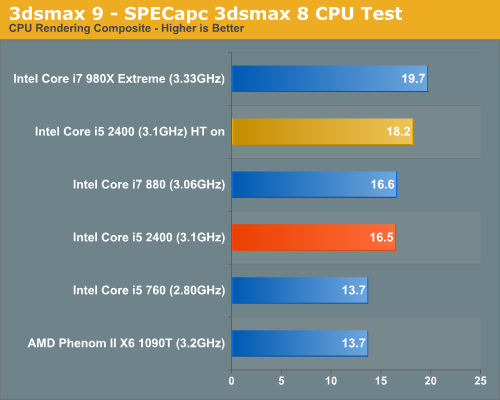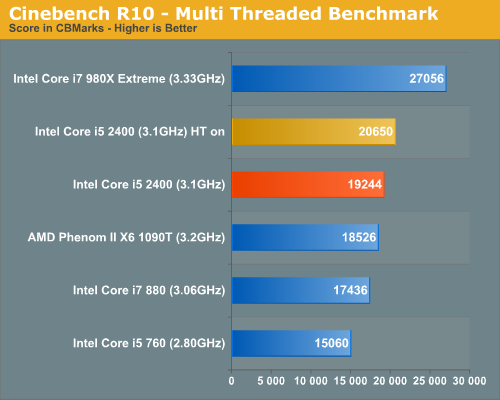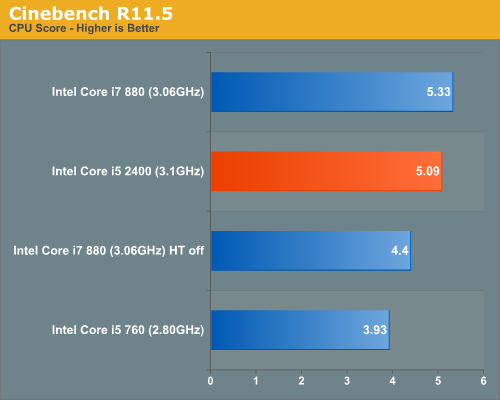The Sandy Bridge Preview
by Anand Lal Shimpi on August 27, 2010 2:38 PM EST3dsmax 9 - SPECapc 3dsmax CPU Rendering Test
Today's desktop processors are more than fast enough to do professional level 3D rendering at home. To look at performance under 3dsmax we ran the SPECapc 3dsmax 8 benchmark (only the CPU rendering tests) under 3dsmax 9 SP1. The results reported are the rendering composite scores:

This is another one of those situations where the Core i5 2400 without Hyper Threading is able to perform on par with the Core i7 880 with Hyper Threading. Compared to the i5 760 it’s 20.5% faster.
With Hyper Threading enabled, the Core i5 2400 is actually dangerously close to the 6-core 980X. Whatever Intel has done to Sandy Bridge's FP is big.
Cinebench R10
Created by the Cinema 4D folks we have Cinebench, a popular 3D rendering benchmark that gives us both single and multi-threaded 3D rendering results.

Cinebench was particularly surprising because it gives us a good opportunity to look at single threaded FP performance. Compared to a similarly clocked Lynnfield, Sandy Bridge can deliver 11% better performance. Compared to a similarly positioned Lynnfield, Sandy Bridge is about 20% faster. Note that this is without turbo enabled. The retail 3.1GHz chip should turbo up to 3.4GHz in this test, giving it a 9.6% frequency boost.
In the multithreaded test Sandy Bridge’s per-core performance is even better than Lynnfield with HT enabled.

I also ran a few numbers using Cinebench R11.5. I didn’t have the opportunity to test the i5 2400 with HT enabled in this test so I measured performance of the i7 880 with HT enabled/disabled to compare per-thread performance.

Sandy Bridge's FP performance is very good. Clock for clock we see a 15.6% improvement over Lynnfield (4C/4T vs. 4C/4T). Compared to the proposed similarly priced Core i5 760, the i5 2400 would be 29.5% faster.
POV-Ray 3.73 beta 23 Ray Tracing Performance
POV-Ray is a popular, open-source raytracing application that also doubles as a great tool to measure CPU floating point performance.
I ran the SMP benchmark in beta 23 of POV-Ray 3.73. The numbers reported are the final score in pixels per second.

The similarly positioned/priced Core i5 760 is beat by 17%. There’s no replacement for more cores/threads however as the i7 880 and X6 parts both pull ahead. Turn on HT to level the playfield (at least within Intel) and Sandy Bridge is 15% faster than Lynnfield.










200 Comments
View All Comments
Touche - Friday, August 27, 2010 - link
And the naming...OMG!There will be i7 processors that require three (3 !!!) different sockets! Maybe even 4 when 2011 comes. Intel can't get their naming right for quite some time now, but they've outdone themselves this time.
ereavis - Monday, August 30, 2010 - link
Processor names really should mean something, even if AMD and Intel don't agree. It's annoying that I have to wikipedia a processor (or memorize a thousand processors) to know what it is. We are still getting quotes for three year old Opterons and Xeons (that we're using as desktops no less), those only add to the annoyance.What ends up happening - good for Intel bad for technology advancement - is non IT type people buying computers are buying DDR2-667 based three-year old desktop processors.
BSMonitor - Friday, August 27, 2010 - link
Ummm, but Bulldozer comes with AM3-r2... Just a sketchier way of saying new MB needed.At least this new Intel isn't trying to BS you. Significant revisions to the architecture require different pin layouts/counts... It is inevitable with processor evolution.
Touche - Friday, August 27, 2010 - link
Actually, it should be AM3 compatible:http://www.tomshardware.com/reviews/bulldozer-bobc...
Even if it's not, AM2/AM3 lasted quite some time.
"At least this new Intel isn't trying to BS you. Significant revisions to the architecture require different pin layouts/counts... It is inevitable with processor evolution."
They know in advance what they need and could design a socket to support multiple processors. And i7/i5/i3 definitely don't need different ones.
BSMonitor - Friday, August 27, 2010 - link
"Even if it's not, AM2/AM3 lasted quite some time."Not all AM2 processors were compatible with AM2+ MB or vice versa, not all AM3 processors compatible on AM2+ MB.
It's still 3 different sockets.
Marketing buddy, marketing.
By the time 1366 is replaced, it will have been on the market for 4 years.
stmok - Saturday, August 28, 2010 - link
Eh, no its not. Bulldozer does NOT work with non-AM3+ mobosAMD engineers made a decision not to make it backward compatible for three reasons.
(1) No one but enthusiasts upgrade their CPUs. People in the real world upgrade their whole computer.
(2) Bulldozer introduces new features that won't work with existing Socket AM3 mobos. (Isn't it bloody obvious when they have to introduce a new socket specification?)
(3) It would cost more money and delays if they were to make a backward compatible version of Bulldozer.
As a result, they made a compromise:
You can take your existing AM3 CPU to AM3+ mobos, while you wait for Bulldozer to arrive. BUT, you can NOT upgrade your existing AM3 based system to Bulldozer.
Simply put...
AM3+ CPU and AM3+ mobo = OK
AM3 CPU and AM3+ mobo = OK
AM3+ CPU and AM3 mobo = Sorry. No.
So it doesn't matter if AMD "Bulldozer" or Intel "Sandy Bridge". You will need a new mobo.
Ard - Friday, August 27, 2010 - link
AMD seriously has their work cut out for them with Bulldozer. The lowest end Sandy Bridge processor absolutely trounced the competition. It's insane what Intel is pulling off here, especially in the integrated graphics arena. Really makes me hope Larrabee comes back as a discrete product in the next few years.dgz - Saturday, August 28, 2010 - link
poor kid, you don't realize 2400 is not nearly lowest end.Finally - Sunday, August 29, 2010 - link
Doesn't that make him a "(filthy) rich kid"?Quodlibet - Friday, August 27, 2010 - link
- based on the shown roadmap, the replacement for the i5 760 is actually the i5 2500(K).- i7 will have even better performance with 8 MB L3 Cache and higher graphics turbo. So there is even more performance potential in the SandyBridge die that Intel could unlock for lower SKUs if needed.